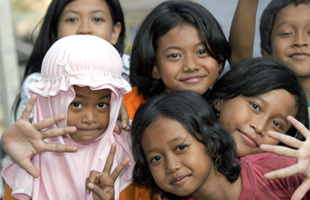It's time for change
At this moment, somewhere in virtually any country in the world, there's a 12-year-old girl scared and confused because she does not know why she is bleeding. She is unaware and unprepared for the changes occurring in her body as a result of puberty. No one ever told her about menstruation and she does not know where to seek help.
Around the world, far too many girls learn about menstruation on the day their period starts. It may seem shocking or absurd that this happens, but many girls aren't educated about sexual and reproductive health. Their families, communities and schools have failed them.
In many countries, it's now easier for adolescents to gain access to pornography through the internet or mobile phones than it is to talk to a trusted adult or get advice from a doctor or nurse. So instead of getting sound information about how to make healthy choices, girls are being flooded with mixed messages.
Celebrating the International Day of the Girl Child (October 11), our vision should be to empower every girl - all 600 million of them aged 10 to 19 around the world - to make healthy choices about their bodies well before they become women.
Here is what needs to happen:
A broad societal response
First: We need to acknowledge that keeping adolescent girls healthy requires a broad response across society - not just in the health sector.
Recently, the World Health Organization, together with partner organizations, launched the Global Strategy for Women's, Children's and Adolescents' Health which, for the first time recognizes that the world must meet adolescent girls' unique health challenges. If we fail at this task, we will not meet the 2030 Global Goals signed off at the United Nations in September.
Our research shows that investments in reducing child marriage by 10% could cut the number of deaths related to pregnancy and childbirth by more than two-thirds. A first and important step is enacting laws and raising the minimum age of marriage, as countries such as Malawi have recently done.
It also means providing free and mandatory education for girls, since we know education-- particularly investments to ensure girls complete secondary school-- can delay pregnancies and improve infant mortality rates.
Laws on their own can't stop 37 000 girls from becoming child brides every day or keep 30 million girls safe from female genital mutilation during the next decade. We need all parts of government and society to work together to keep girls in school, give them jobs and help change cultural norms. The new Global Strategy, provided its goals are fully realized, can ensure we're engaging everyone.
Global Standards for quality health-care services for adolescents
Second: We need global standards for adolescent health care that all countries can follow to keep girls healthy as they grow into women, Currently, health-care services in most countries are not meeting the unique needs of adolescent girls, who are rapidly developing both physically and emotionally.
Together with UNAIDS, WHO developed the first Global Standards for quality health-care services for adolescents, which aims to help countries provide more adolescent responsive services.
As girls become sexually active, they require an integrated package of services, including contraception methods, access to safe abortions to the full extent of the law, management of the consequences from unsafe abortion, testing and treatment of sexually transmitted infections and sensitive care following sexual violence. Most important, they need health services that are confidential, and that address their needs in a comprehensive manner.
We know for example, that poor mental health may negatively impact sexual and reproductive health outcomes, and vice versa. Today, depression is the leading cause of disease burden in girls aged 10-19, and suicide is the leading cause of death among girls aged 15-19. It is our failure when a girl sees self-harm as the only way to deal with a situation.
Health services should also be free or low-cost and provided by health care professionals who are non-judgmental, trained in providing age-appropriate health information and friendly towards adolescents. Additionally, adolescents should not have to make an appointment or gain parental consent to receive time-sensitive preventive services like birth control, psychological counselling or testing for sexually transmitted diseases.
More than 'girl power'
There has been a lot of talk in recent years about "girl power". But we still need powerful changes across society to give adolescent girls the support they need to grow into healthy women with satisfying lives.
Follow me @Dr Flavia Bustreo and on our World Health Organization Life-course website to find out more about adolescent, family, women's and children's health through the life-course, within human rights, and the social and environmental determinants of health.

